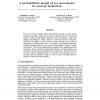Free Online Productivity Tools
i2Speak
i2Symbol
i2OCR
iTex2Img
iWeb2Print
iWeb2Shot
i2Type
iPdf2Split
iPdf2Merge
i2Bopomofo
i2Arabic
i2Style
i2Image
i2PDF
iLatex2Rtf
Sci2ools
IJON
2007
2007
A probabilistic model of eye movements in concept formation
It has been unclear whether optimal experimental design accounts of data selection may offer insight into evidence acquisition tasks in which the learner’s beliefs change greatly during the course of learning. Data from Rehder and Hoffman’s (2003, 2005) eye movement version of Shepard, Hovland, and Jenkins’s (1961) classic concept learning task provide an opportunity to address these issues. We introduce a principled probabilistic concept-learning model that describes the development of subjects’ beliefs on that task. We use that learning model, together with a sampling function inspired by theory of optimal experimental design, to predict subjects’ eye movements on the active learning version of that task. Results show that the same rational sampling function can predict eye movements early in learning, when uncertainty is high, as well as late in learning when the learner is certain of the true category.
| Added | 15 Dec 2010 |
| Updated | 15 Dec 2010 |
| Type | Journal |
| Year | 2007 |
| Where | IJON |
| Authors | Jonathan D. Nelson, Garrison W. Cottrell |
Comments (0)

